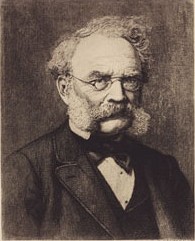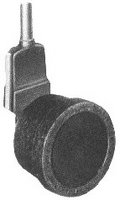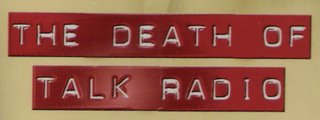Now that the election is over and the Democratic party has trampled the Republicans and taken both houses I feel a sense of civility and prosperity is in the air. [
I GUESS HE DIDN'T REALLY HAVE THAT MANDATE FROM GOD HUH?] I feel calmer: Less inclined to get into a political rank... back to the business of radio trivia...

One of the most notable radio preachers was the one and only Rev. Carl McIntire. He died on March 19th, 2002 at the ripe old age of 95. During the peak of his popularity his program was carried on over 600 radio stations in the U.S. and Canada every week. Carl was popularly known as "'The P.T. Barnum of Fundamentalism" but his program "the 20th Century Reformation Hour" Pulled down over 34 million dollars in donations annually.
LinkRev. McIntire was what we now call a "fundie." Much like Rick Santorum he had a pretty strong interest in what goes on in other peoples bedrooms. Kind of like a peeping tom except he wants you to stop. He rallied against racial integration, Jews, Catholics, Communists, sex education, evolution, liberals, and even water fluoridation. Damn that Fluoride and those ungodly healthy teeth! But in his defense he also attacked religious groups such as the World Council of Churches and even denounced fellow radio preacher Oral Roberts. He was an even handed crank, I'll give him that.
In 1970, the FCC gave him the ultimate fairness doctrine spanking and took away his
WXUR broadcast license. It was the flagship station, and housed the studio where his weekly "
20th Century Reformation Hour" radio program originated. The Feds accused him of "consistently violating the fairness doctrine." Carl had mortgaged Faith Seminary for $425,000 to buy
WXUR-AM &
WXUR‑FM in Media PA. Needless to say, it hurt his feelings.
The FCC did not act alone. In fact his license renewal was opposed by many of the groups he'd spent years attacking. This includes but is not limited to: the Greater Philadelphia Council of Churches, the New Jersey Council of Churches, the American Jewish Congress, the Anti‑Defamation League of B’nai B’rith, the Catholic Community Relations Council, the National Association for the Advancement of Colored People and the AFL‑CIO. He pissed off everybody. He appealed, and even the The Federal Circuit Court of Appeals told him he was a rude prick and to find a new job. (
they said it nicer than that)
WXUR was forced off air on July 6, 1973.
This would hardly be notable except that McIntire then started an unlicensed pirate radio station on a boat off the coast of New Jersey! A radio man, a pastor and a pirate. You gotta love that. He took some of those millions of dollars in donations and bought a boat. A big boat, a 140 foot minesweeper, the Oceanic; and turned it into a floating broadcast station. He anchored it twelve miles out to sea, in international waters and crossed his fingers. More
here.
McIntire began broadcasting at 1160 kHz on the AM dial off Cape May, New Jersey with a 10,000 watt transmitter. He also armed the ship with a cache of rifles intended to ward off "Soviet Communists." His broadcasts, while amusing, were also interfering with other LICENSED radio stations. These included 1170
WHLW-AM and even the distant
1100 KSL-AM in Salt Lake City, UT. Many filed complaints with the FCC. McIntire voluntarily closed down without any gunfire.

McIntire intended to just change frequencies, but the FCC obtained a temporary injunction halting further pirate transmissions from the Columbus. But how could that stop him.. he's a pirate in international waters.... Well, McIntire was not a lawyer. He had overlooked an international agreement made in Geneva and ratified by the U.S. Congress in 1961.
Article 7, Section 1 of the International Telecommunications Convention prohibits the unlicensed broadcasts by American ships anywhere. section 301 of the Communications Act of 1934, (Act), 47 U.S.C. Sec. 301, affords the FCC direct regulatory power over any craft of US registry.Carl went a little nutty and claimed the CIA framed him. But here at his peak of lunacy he began to seem very appealing to some congressmen. Representative John E. Hunt, Republican of New Jersey, and Representative John R. Rarick, Republican of Louisiana, introduced bills to force the FCC to renew
WXUR's license. The District Court still handed down a permanent injunction. He relinquished the Columbus, and its equipment in the face of a tax suit by the state of NJ. , Cape May officials billed McIntire for nearly $550,000 total in taxes and interest.
Believe it or not, he's still rolling today. His show is still on the air but he still can't own or operate a radio station.

 dynamic microphone has a lower noise or distortion level than that of the carbon microphone and required no power to operate.
dynamic microphone has a lower noise or distortion level than that of the carbon microphone and required no power to operate. 

 Above is pictured the transmitter building for KMLT, Thousand Oaks, CA. notice that you see nothing. That is because it's buried underground to satisfy the community's "Open Space" land-use regulation. Personally I am impressed. More pictures
Above is pictured the transmitter building for KMLT, Thousand Oaks, CA. notice that you see nothing. That is because it's buried underground to satisfy the community's "Open Space" land-use regulation. Personally I am impressed. More pictures  McIntire intended to just change frequencies, but the FCC obtained a temporary injunction halting further pirate transmissions from the Columbus. But how could that stop him.. he's a pirate in international waters.... Well, McIntire was not a lawyer. He had overlooked an international agreement made in Geneva and ratified by the U.S. Congress in 1961.
McIntire intended to just change frequencies, but the FCC obtained a temporary injunction halting further pirate transmissions from the Columbus. But how could that stop him.. he's a pirate in international waters.... Well, McIntire was not a lawyer. He had overlooked an international agreement made in Geneva and ratified by the U.S. Congress in 1961.




